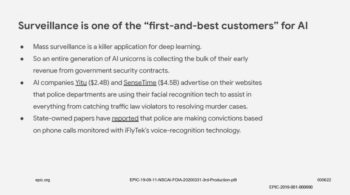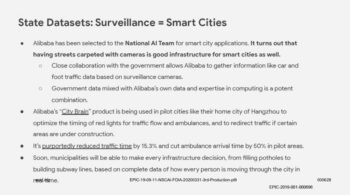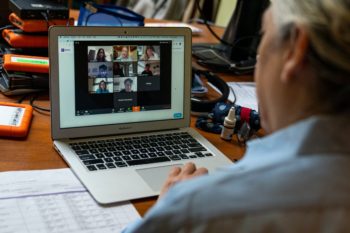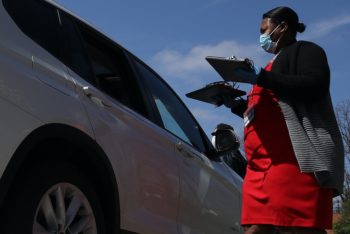FOR A FEW fleeting moments during New York Gov. Andrew Cuomo’s daily coronavirus briefing on Wednesday, the somber grimace that has filled our screens for weeks was briefly replaced by something resembling a smile.
“We are ready, we’re all-in,” the governor gushed.
We are New Yorkers, so we’re aggressive about it, we’re ambitious about it.… We realize that change is not only imminent, but it can actually be a friend if done the right way.
The inspiration for these uncharacteristically good vibes was a video visit from former Google CEO Eric Schmidt, who joined the governor’s briefing to announce that he will be heading up a blue-ribbon commission to reimagine New York state’s post-Covid reality, with an emphasis on permanently integrating technology into every aspect of civic life.
“The first priorities of what we’re trying to do,” Schmidt said, “are focused on telehealth, remote learning, and broadband.… We need to look for solutions that can be presented now, and accelerated, and use technology to make things better.” Lest there be any doubt that the former Google chair’s goals were purely benevolent, his video background featured a framed pair of golden angel wings.
Just one day earlier, Cuomo had announced a similar partnership with the Bill and Melinda Gates Foundation to develop “a smarter education system.” Calling Gates a “visionary,” Cuomo said the pandemic has created “a moment in history when we can actually incorporate and advance [Gates’s] ideas… all these buildings, all these physical classrooms–why with all the technology you have?” he asked, apparently rhetorically.
It has taken some time to gel, but something resembling a coherent Pandemic Shock Doctrine is beginning to emerge. Call it the “Screen New Deal.” Far more high-tech than anything we have seen during previous disasters, the future that is being rushed into being as the bodies still pile up treats our past weeks of physical isolation not as a painful necessity to save lives, but as a living laboratory for a permanent–and highly profitable–no-touch future.
Anuja Sonalker, CEO of Steer Tech, a Maryland-based company selling self-parking technology, recently summed up the new virus-personalized pitch. “There has been a distinct warming up to human-less, contactless technology,” she said.
Humans are biohazards, machines are not.
It’s a future in which our homes are never again exclusively personal spaces but are also, via high-speed digital connectivity, our schools, our doctor’s offices, our gyms, and, if determined by the state, our jails. Of course, for many of us, those same homes were already turning into our never-off workplaces and our primary entertainment venues before the pandemic, and surveillance incarceration “in the community” was already booming. But in the future under hasty construction, all of these trends are poised for a warp-speed acceleration.
This is a future in which, for the privileged, almost everything is home delivered, either virtually via streaming and cloud technology, or physically via driverless vehicle or drone, then screen “shared” on a mediated platform. It’s a future that employs far fewer teachers, doctors, and drivers. It accepts no cash or credit cards (under guise of virus control) and has skeletal mass transit and far less live art. It’s a future that claims to be run on “artificial intelligence” but is actually held together by tens of millions of anonymous workers tucked away in warehouses, data centers, content moderation mills, electronic sweatshops, lithium mines, industrial farms, meat-processing plants, and prisons, where they are left unprotected from disease and hyperexploitation. It’s a future in which our every move, our every word, our every relationship is trackable, traceable, and data-mineable by unprecedented collaborations between government and tech giants.
If all of this sounds familiar it’s because, pre-Covid, this precise app-driven, gig-fueled future was being sold to us in the name of convenience, frictionlessness, and personalization. But many of us had concerns. About the security, quality, and inequity of telehealth and online classrooms. About driverless cars mowing down pedestrians and drones smashing packages(and people). About location tracking and cash-free commerce obliterating our privacy and entrenching racial and gender discrimination. About unscrupulous social media platforms poisoning our information ecology and our kids’ mental health. About “smart cities” filled with sensors supplanting local government. About the good jobs these technologies wiped out. About the bad jobs they mass produced.
And most of all, we had concerns about the democracy-threatening wealth and power accumulated by a handful of tech companies that are masters of abdication–eschewing all responsibility for the wreckage left behind in the fields they now dominate, whether media, retail, or transportation.
That was the ancient past known as February. Today, a great many of those well-founded concerns are being swept away by a tidal wave of panic, and this warmed-over dystopia is going through a rush-job rebranding. Now, against a harrowing backdrop of mass death, it is being sold to us on the dubious promise that these technologies are the only possible way to pandemic-proof our lives, the indispensable keys to keeping ourselves and our loved ones safe.
Thanks to Cuomo and his various billionaire partnerships (including one with Michael Bloomberg for testing and tracing), New York state is being positioned as the gleaming showroom for this grim future–but the ambitions reach far beyond the borders of any one state or country.
And at the dead center of it all is Eric Schmidt. Well before Americans understood the threat of COVID-19, Schmidt had been on an aggressive lobbying and public relations campaign pushing precisely the “Black Mirror” vision of society that Cuomo has just empowered him to build. At the heart of this vision is seamless integration of government with a handful of Silicon Valley giants–with public schools, hospitals, doctor’s offices, police, and military all outsourcing (at a high cost) many of their core functions to private tech companies.
It’s a vision Schmidt has been advancing in his roles as chair of the Defense Innovation Board, which advises the Department of Defense on increased use of artificial intelligence in the military, and as chair of the powerful National Security Commission on Artificial Intelligence, or NSCAI, which advises Congress on “advances in artificial intelligence, related machine learning developments, and associated technologies,” with the goal of addressing “the national and economic security needs of the United States, including economic risk.” Both boards are crowded with powerful Silicon Valley CEOS and top executives from companies including Oracle, Amazon, Microsoft, Facebook, and of course, Schmidt’s colleagues at Google.

Eric Schmidt, executive chair of Alphabet Inc., Google’s parent company, speaks during a National Security Commission on Artificial Intelligence conference on Nov. 5, 2019 in Washington, D.C. Photo: Alex Wong/Getty Images
AS CHAIR, SCHMIDT, who still holds more than $5.3 billion in shares of Alphabet (Google’s parent company), as well as large investments in other tech firms, has essentially been running a Washington-based shakedown on behalf of Silicon Valley. The main purpose of the two boards is to call for exponential increases in government spending on research into artificial intelligence and on tech-enabling infrastructure like 5G–investments that would directly benefit the companies in which Schmidt and other members of these boards have extensive holdings.
First in closed-door presentations to lawmakers and later in public-facing op-eds and interviews, the thrust of Schmidt’s argument has been that since the Chinese government is willing to spend limitless public money building the infrastructure of high-tech surveillance, while allowing Chinese tech companies like Alibaba, Baidu, and Huawei to pocket the profits from commercial applications, the U.S.’s dominant position in the global economy is on the precipice of collapsing.
The Electronic Privacy Information Center recently got access through a Freedom of Information Act request to a presentation made by Schmidt’s NSCAI one year ago, in May 2019. Its slides make a series of alarmist claims about how China’s relatively lax regulatory infrastructure and its bottomless appetite for surveillance are causing it to pull ahead of the U.S. in a number of fields, including “AI for medical diagnosis,” autonomous vehicles, digital infrastructure, “smart cities,” ride-sharing, and cashless commerce.
The reasons given for China’s competitive edge are myriad, ranging from the sheer volume of consumers who shop online; “the lack of legacy banking systems in China,” which has allowed it to leapfrog over cash and credit cards and unleash “a huge e-commerce and digital services market” using “digital payments”; and a severe doctor shortage, which has led the government to work closely with tech companies like Tencent to use AI for “predictive” medicine. The slides note that in China, tech companies
have the authority to quickly clear regulatory barriers while American initiatives are mired in HIPPA compliance and FDA approval.
 More than any other factor, however, the NSCAI points to China’s willingness to embrace public-private partnerships in mass surveillance and data collection as a reason for its competitive edge. The presentation touts China’s “Explicit government support and involvement e.g. facial recognition deployment.” It argues that “surveillance is one of the ‘first-and-best customers’ for Al” and further, that “mass surveillance is a killer application for deep learning.”
More than any other factor, however, the NSCAI points to China’s willingness to embrace public-private partnerships in mass surveillance and data collection as a reason for its competitive edge. The presentation touts China’s “Explicit government support and involvement e.g. facial recognition deployment.” It argues that “surveillance is one of the ‘first-and-best customers’ for Al” and further, that “mass surveillance is a killer application for deep learning.”
A slide titled “State Datasets: Surveillance = Smart Cities” notes that China, along with Google’s main Chinese competitor, Alibaba, are racing ahead.
This is notable because Google’s parent company Alphabet has been pushing this precise vision through its Sidewalk Labs division, choosing a large portion of Toronto’s waterfront as its “smart city” prototype. But the Toronto project was just shut down after two years of ceaseless controversy relating to the enormous amounts of personal data that Alphabet would collect, a lack of privacy protections, and questionable benefits for the city as a whole.
 Five months after this presentation, in November, NSCAI issued an interim report to Congress further raising the alarm about the need for the U.S. to match China’s adaptation of these controversial technologies. “We are in a strategic competition,” states the report, obtained via FOIA by the Electronic Privacy Information Center.
Five months after this presentation, in November, NSCAI issued an interim report to Congress further raising the alarm about the need for the U.S. to match China’s adaptation of these controversial technologies. “We are in a strategic competition,” states the report, obtained via FOIA by the Electronic Privacy Information Center.
AI will be at the center. The future of our national security and economy are at stake.
By late February, Schmidt was taking his campaign to the public, perhaps understanding that the budget increases his board was calling for could not be approved without a great deal more buy-in. In a New York Times op-ed headlined “I used to Run Google. Silicon Valley Could Lose to China,” Schmidt called for “unprecedented partnerships between government and industry” and, once again, sounding the yellow peril alarm:
A.I. will open new frontiers in everything from biotechnology to banking, and it is also a Defense Department priority.… If current trends continue, China’s overall investments in research and development are expected to surpass those of the United States within 10 years, around the same time its economy is projected to become larger than ours.
Unless these trends change, in the 2030s we will be competing with a country that has a bigger economy, more research and development investments, better research, wider deployment of new technologies and stronger computing infrastructure. … Ultimately, the Chinese are competing to become the world’s leading innovators, and the United States is not playing to win.
The only solution, for Schmidt, was a gusher of public money. Praising the White House for requesting a doubling of research funding in AI and quantum information science, he wrote:
We should plan to double funding in those fields again as we build institutional capacity in labs and research centers.… At the same time, Congress should meet the president’s request for the highest level of defense R & D funding in over 70 years, and the Defense Department should capitalize on that resource surge to build breakthrough capabilities in A.I., quantum, hypersonics and other priority technology areas.
That was exactly two weeks before the coronavirus outbreak was declared a pandemic, and there was no mention that a goal of this vast, high-tech expansion was to protect American health. Only that it was necessary to avoid being outcompeted by China. But, of course, that would soon change.
In the two months since, Schmidt has put these preexisting demands–for massive public expenditures on high-tech research and infrastructure, for a slew of “public-private partnerships” in AI, and for the loosening of myriad privacy and safety protections–through an aggressive rebranding exercise. Now all of these measures (and more) are being sold to the public as our only possible hope of protecting ourselves from a novel virus that will be with us for years to come.
And the tech companies to which Schmidt has deep ties, and which populate the influential advisory boards he chairs, have all repositioned themselves as benevolent protectors of public health and munificent champions of “everyday hero” essential workers (many of whom, like delivery drivers, would lose their jobs if these companies get their way). Less than two weeks into New York state’s lockdown, Schmidt wrote an op-ed for the Wall Street Journal that both set the new tone and made clear that Silicon Valley had every intention of leveraging the crisis for a permanent transformation.
Like other Americans, technologists are trying to do their part to support the front-line pandemic response.…
But every American should be asking where we want the nation to be when the COVID-19 pandemic is over. How could the emerging technologies being deployed in the current crisis propel us into a better future? … Companies like Amazon know how to supply and distribute efficiently. They will need to provide services and advice to government officials who lack the computing systems and expertise.
We should also accelerate the trend toward remote learning, which is being tested today as never before. Online, there is no requirement of proximity, which allows students to get instruction from the best teachers, no matter what school district they reside in. …
The need for fast, large-scale experimentation will also accelerate the biotech revolution. … Finally, the country is long overdue for a real digital infrastructure…. If we are to build a future economy and education system based on tele-everything, we need a fully connected population and ultrafast infrastructure. The government must make a massive investment—perhaps as part of a stimulus package—to convert the nation’s digital infrastructure to cloud-based platforms and link them with a 5G network.
Indeed Schmidt has been relentless in pursuing this vision. Two weeks after that op-ed appeared, he described the ad-hoc homeschooling programing that teachers and families across the country had been forced to cobble together during this public health emergency as “a massive experiment in remote learning.” The goal of this experiment, he said, was “trying to find out: How do kids learn remotely? And with that data we should be able to build better remote and distance learning tools which, when combined with the teacher … will help kids learn better.” During this same video call, hosted by the Economic Club of New York, Schmidt also called for more telehealth, more 5G, more digital commerce, and the rest of the preexisting wish list. All in the name of fighting the virus.
His most telling comment, however, was this: “The benefit of these corporations, which we love to malign, in terms of the ability to communicate, the ability to deal with health, the ability to get information, is profound. Think about what your life would be like in America without Amazon.” He added that people should
be a little bit grateful that these companies got the capital, did the investment, built the tools that we’re using now, and have really helped us out.

Associate professor Carol Dysinger, right, of New York University’s Tisch School of the Arts conducts her weekly remote-learning class for the graduate school filmmaking students on April 9, 2020 at her apartment in Brooklyn, N.Y. Photo: Robert Nickelsberg/Getty Images
IT’S A REMINDER that, until very recently, public pushback against these companies was surging. Presidential candidates were openly discussing breaking up big tech. Amazon was forced to pull its plans for a New York headquarters because of fierce local opposition. Google’s Sidewalk Labs project was in perennial crisis, and Google’s own workers were refusing to build surveillance tech with military applications.
In short, democracy–inconvenient public engagement in the designing of critical institutions and public spaces–was turning out to be the single greatest obstacle to the vision Schmidt was advancing, first from his perch at the top of Google and Alphabet and then as chair of two powerful boards advising Congress and Department of Defense. As the NSCAI documents reveal, this inconvenient exercise of power by members of the public and by tech workers inside these mega-firms, has, from the perspective of men like Schmidt and Amazon CEO Jeff Bezos, maddeningly slowed down the AI arms race, keeping fleets of potentially deadly driverless cars and trucks off the roads, protecting private health records from becoming a weapon used by employers against workers, preventing urban spaces from being blanketing with facial recognition software, and much more.
Now, in the midst of the carnage of this ongoing pandemic, and the fear and uncertainty about the future it has brought, these companies clearly see their moment to sweep out all that democratic engagement. To have the same kind of power as their Chinese competitors, who have the luxury of functioning without being hampered by intrusions of either labor or civil rights.
All of this is moving very fast. The Australian government has contracted with Amazon to store the data for its controversial coronavirus tracking app. The Canadian government has contracted with Amazon to deliver medical equipment, raising questions about why it bypassed the public postal service. And in just a few short days in early May, Alphabet has spun up a new Sidewalk Labs initiative to remake urban infrastructure with $400 million in seed capital. Josh Marcuse, executive director of the Defense Innovation Board that Schmidt chairs, announced that he was leaving that job to work full-time at Google as head of strategy and innovation for global public sector, meaning that he will be helping Google to cash in on some of the many opportunities he and Schmidt have been busily creating with their lobbying.
To be clear, technology is most certainly a key part of how we must protect public health in the coming months and years. The question is: Will that technology be subject to the disciplines of democracy and public oversight, or will it be rolled out in state-of-exception frenzy, without asking critical questions that will shape our lives for decades to come? Questions like, for instance: If we are indeed seeing how critical digital connectivity is in times of crisis, should these networks, and our data, really be in the hands of private players like Google, Amazon, and Apple? If public funds are paying for so much of it, should the public also own and control it? If the internet is essential for so much in our lives, as it clearly is, should it be treated as a nonprofit public utility?
And while there is no doubt that the ability to teleconference has been a lifeline in this period of lockdown, there are serious debates to be had about whether our more lasting protections are distinctly more human. Take education. Schmidt is right that overcrowded classrooms present a health risk, at least until we have a vaccine. So how about hiring double the number of teachers and cutting class size in half? How about making sure that every school has a nurse?
That would create much-needed jobs in a depression-level unemployment crisis and give everyone in the learning environment more elbow room. If buildings are too crowded, how about dividing the day into shifts, and having more outdoor education, drawing on the plentiful research that shows that time in nature enhances children’s capacity to learn?
Introducing those kinds of changes would be hard, to be sure. But they are not nearly as risky as giving up on the tried-and-true technology of trained humans teaching younger humans face-to-face, in groups where they learn to socialize with one another to boot.
Upon learning of New York state’s new partnership with the Gates Foundation, Andy Pallotta, president of New York State United Teachers, was quick to react: “If we want to reimagine education, let’s start with addressing the need for social workers, mental health counselors, school nurses, enriching arts courses, advanced courses and smaller class sizes in school districts across the state,” he said. A coalition of parents’ groups also pointed out that if they had indeed been living an “experiment in remote learning” (as Schmidt put it), then the results were deeply worrying:
Since the schools were shut down in mid-March, our understanding of the profound deficiencies of screen-based instruction has only grown.

Staff members at Woodlin Elementary School distribute computers to parents of Montgomery County students on March 26, 2020 in Silver Spring, Md. Photo: Win McNamee/Getty Images
IN ADDITION TO the obvious class and race biases against children who lack internet access and home computers (problems that tech companies are eager to be paid to solve with massive tech buys), there are big questions about whether remote teaching can serve many kids with disabilities, as required by law. And there is no technological solution to the problem of learning in a home environment that is overcrowded and/or abusive.
The issue is not whether schools must change in the face of a highly contagious virus for which we have neither cure nor inoculation. Like every institution where humans gather in groups, they will change. The trouble, as always in these moments of collective shock, is the absence of public debate about what those changes should look like and whom they should benefit. Private tech companies or students?
The same questions need to be asked about health. Avoiding doctor’s offices and hospitals during a pandemic makes good sense. But telehealth misses a huge amount. So we need to have an evidence-based debate about the pros and cons of spending scarce public resources on telehealth–versus on more trained nurses, equipped with all the necessary protective equipment, who are able to make house calls to diagnose and treat patients in their homes. And perhaps most urgently, we need to get the balance right between virus tracking apps, which with the proper privacy protections have a role to play, and the calls for a Community Health Corps that would put millions of Americans to work not only doing contact tracing but making sure that everyone has the material resources and support they need to quarantine safely.
In each case, we face real and hard choices between investing in humans and investing in technology. Because the brutal truth is that, as it stands, we are very unlikely to do both. The refusal to transfer anything like the needed resources to states and cities in successive federal bailouts means that the coronavirus health crisis is now slamming headlong into a manufactured austerity crisis. Public schools, universities, hospitals, and transit are facing existential questions about their futures. If tech companies win their ferocious lobbying campaign for remote learning, telehealth, 5G, and driverless vehicles–their Screen New Deal–there simply won’t be any money left over for urgent public priorities, never mind the Green New Deal that our planet urgently needs.
On the contrary: The price tag for all the shiny gadgets will be mass teacher layoffs and hospital closures.
Tech provides us with powerful tools, but not every solution is technological. And the trouble with outsourcing key decisions about how to “reimagine” our states and cities to men like Bill Gates and Eric Schmidt is that they have spent their lives demonstrating the belief that there is no problem that technology cannot fix.
For them, and many others in Silicon Valley, the pandemic is a golden opportunity to receive not just the gratitude, but the deference and power that they feel has been unjustly denied. And Andrew Cuomo, by putting the former Google chair in charge of the body that will shape the state’s reopening, appears to have just given him something close to free reign.
This is the first installment in an ongoing series about the shock doctrine and disaster capitalism in the age of COVID-19.

